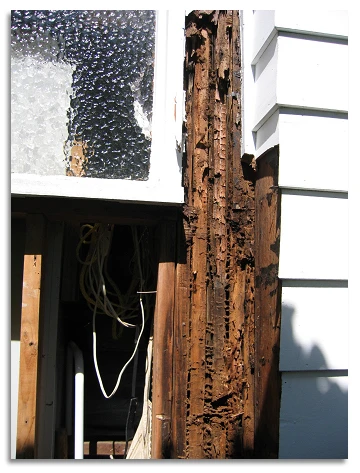Wood Rot Repair | 10 Places to Check for Potential Wood Rot
How common is wood rot? According to Ohio State University Extension entomologist, William F. Lyon, nearly 10 percent of the wood produced in the U.S. annually, serves as replacement material for damage caused by wood decay. Early identification serves as the key to avoiding extensive and costly repairs. Learn what causes the problem and the 10 places you should regularly check for wood rot in and on your home. 
What is Wood Rot?
It helps to understand what causes wood decay, so you can more easily spot it. Fungal colonies are the culprit, and two classes of wood rot exist. One results in a brown discoloration and crumbly appearance, lending it the name "brown cubical rot." The other has a white or yellow look, and the wood becomes stringy or spongy. The fungi grow when dry wood comes into contact with moist soil or repeated condensation, such as from leaking plumbing or downspouts. Fungi also can extend for 30 feet or more across non-wood substances to wood.
10 Places to Look for Wood Rot
Several spots in and on your home lend themselves to the potential for wood rot. Regularly check the following areas to catch the fungus before it does serious damage:
- Attic - A leak in your roof can allow water to seep in, causing fungi to grow. Improperly vented dryers or exhaust fans also can cause condensation to form, creating the potential for wood rot.
- Under Sinks - Check under sinks in both the bathrooms and kitchen for leaking pipes. If not caught early enough, a leak can result in wood rot in the cabinet floor and subfloor beneath.
- Basement - Improperly graded landscaping surrounding your home can cause water to collect around the foundation and potentially seep into your basement, where it can come into contact with structural and surface wood.
- Windowsills - Sweating windows can create conditions perfect for wood rot in windowsills, both inside your home and out.
- Thresholds - Check for signs of wood rot on thresholds near exterior doors; don't forget any sliding glass doors in your home, where water can seep into the tracks.
- Steps & Stoops - If your home has wooden steps, or a stoop not only exposed to the elements but near moist soil, inspect the areas regularly.
- Decks - Look for signs of wood rot on any posts or other parts of the structure in contact with soil.
- Eaves - Improperly installed roof flashing, a roof leak or clogged gutters create conditions ripe for wood rot.
- Wood Siding - Regularly inspect this most important part of your home for signs of wood decay.
- Fences - Check along the bottom of the fence line, including posts and gates.
Related Posts: Wood Rot Repair Methods to Prevent Damage from Water Intrusion
 Click to call
Click to call


